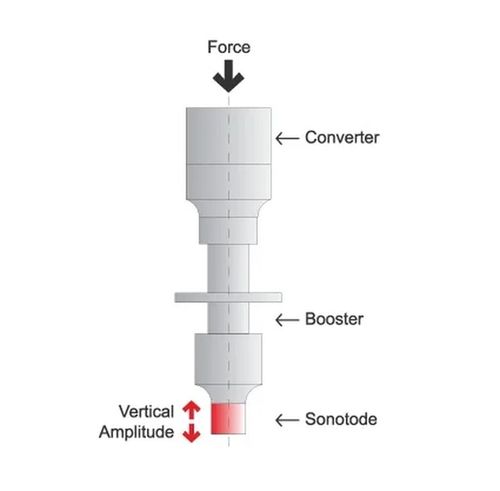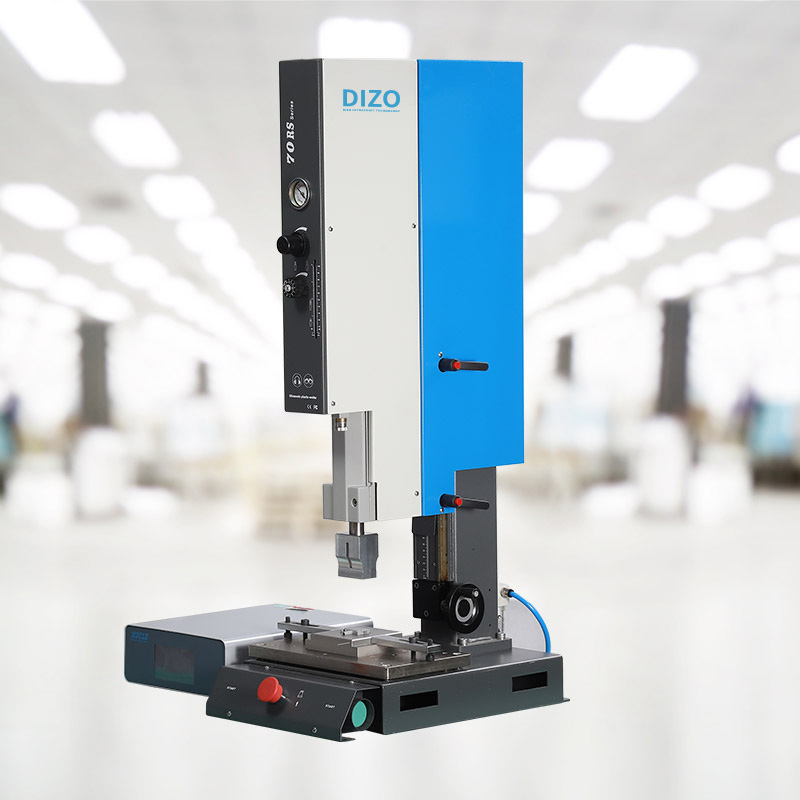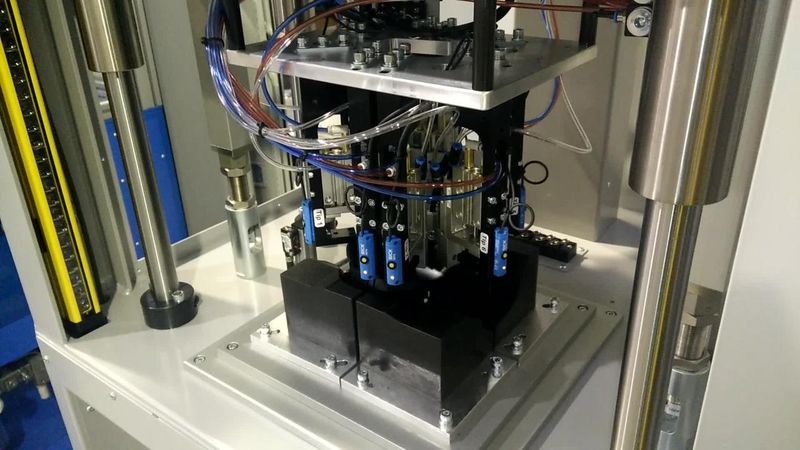Ultrasonic Welding vs Heat Staking: What's the Difference?

Today, two of the most commonly used methods for plastic joining are ultrasonic welding and heat staking. However, these two techniques differ significantly in their processes, applications, and advantages.
Understanding the core differences between ultrasonic welding and heat staking can help manufacturers aiming to optimize production efficiency, material savings, and overall product quality.
This article will explore ultrasonic welding vs heat staking, helping you decide which process best suits your production needs.

Table of Contents
Ultrasonic Welding vs Heat Staking
Principles of Ultrasonic Welding
Ultrasonic Welding Equipment Components
Advantages and Disadvantages of Ultrasonic Welding
Applications of Ultrasonic Welding
Principles of Heat Staking
Heat Staking Equipment Components
Advantages and Disadvantages of Heat Staking
Applications of Heat Staking
Things to Look for When Shopping for the Fastening Tool
Conclusion
Ultrasonic Welding vs Heat Staking
Comparison of Key Metrics
Below is a detailed comparison of the key metrics between ultrasonic welding and heat staking, highlighting their differences in terms of material compatibility, speed, efficiency, precision, control, joint design considerations, and application suitability.
Material Compatibility and Cost
Both ultrasonic welding plastic and heat-staking plastic are compatible with a wide range of thermoplastics. However, ultrasonic welding is particularly well-suited for thin-walled parts and materials such as polycarbonate, polystyrene, and polyethylene.
On the other hand, heat staking works well with thicker materials, such as ABS, polyamide, and other engineering plastics.
The cost of ultrasonic welding tends to be lower than heat staking when considering equipment and operational costs, especially when utilizing ultrasonic welding services that allow manufacturers to outsource the process without the need for their own equipment.

Speed and Efficiency
One of the key advantages of ultrasonic welding over heat staking plastic is speed. Ultrasonic welding process typically takes less than a second to complete, making it ideal for high-volume production environments.
The ultrasonic welding equipment used in these processes is designed for rapid cycle times, reducing downtime and boosting overall productivity.
In contrast, heat staking machines are slower, as they require a more extended heating and cooling period to form a bond, which makes it less efficient for large-scale operations.
Precision and Control
Ultrasonic welding offers greater precision than heat staking. The ultrasonic welding plastic process uses a high-frequency vibration that focuses on the joining point, creating a precise weld with minimal thermal impact on surrounding areas.
In comparison, heat staking relies on mechanical pressure to form a bond, which can be less precise and harder to control.
Joint Design Considerations
The joint design for ultrasonic welding and heat staking can vary significantly. Ultrasonic welding plastic joints are typically simpler and rely on a clean, well-aligned interface.
However, heat staking is more flexible when dealing with complex joint designs, as it can accommodate features like flanges, posts, and more intricate shapes. The tooling used in heat staking machines can be customized to create a wide variety of joint configurations.
Application Suitability
Ultrasonic welding is widely used in industries such as electronics, automotive, and medical devices, where speed, precision, and minimal heat are required.
For example, ultrasonic welding companies often provide ultrasonic welding services to manufacturers of electronic components, where small, delicate parts need to be joined quickly and accurately.
On the other hand, heat staking is typically used in applications where a more robust and durable bond is needed, such as in automotive assembly, heavy-duty consumer goods, or for joining plastic components to metal parts.
Principles of Ultrasonic Welding
Ultrasonic welding uses high-frequency sound waves to generate localized heat at the interface of two plastic parts.
The process begins with an ultrasonic welding machine, which produces ultrasonic vibrations that are applied to the plastic components. These vibrations cause the material at the joint interface to melt due to the friction generated, forming a strong bond once the pressure is applied.
Ultrasonic Welding Equipment Components
The effectiveness of ultrasonic welding relies on the precision of the equipment used. Several key components make up the ultrasonic welding system, each playing a vital role in ensuring the process runs efficiently.

Ultrasonic Generator
The generator is the heart of ultrasonic welding equipment, converting standard electrical energy into high-frequency electrical signals (typically 20-40 kHz). These signals power the transducer to produce ultrasonic vibrations that are transmitted to the parts being welded.
Transducer
The transducer is responsible for converting electrical energy into mechanical energy in the form of ultrasonic vibrations. It uses piezoelectric crystals that vibrate when subjected to high-frequency signals. This mechanical energy is transferred to the sonotrode.
Sonotrode (Horn)
The sonotrode, also known as the horn, is a metal tool that amplifies ultrasonic vibrations. The sonotrode is designed to focus the vibrations on the welding area, ensuring localized heating and precise control over the bonding process.
Fixture
The fixture holds the parts in place during the ultrasonic welding process, maintaining their alignment and ensuring the correct amount of pressure is applied. This component is designed to withstand the vibrations and pressure of the welding process.
Converter
The converter is responsible for transforming the ultrasonic vibrations into mechanical energy that is used to join the materials. It plays a crucial role in ensuring efficient energy transfer during the welding process.
Each of these components works together to ensure the ultrasonic welding process is efficient, precise, and repeatable, providing high-quality, durable welds without the need for additional materials or adhesives.
Advantages and Disadvantages of Ultrasonic Welding
Ultrasonic welding offers a range of advantages that make it a popular choice in industries like automotive, electronics, and medical device manufacturing. The below gives the key advantages and disadvantages of ultrasonic welding, helping you determine when this technique is the best fit for your production needs.

Advantages of Ultrasonic Welding
Speed: Ultrasonic welding is incredibly fast, with a typical welding cycle lasting less than a second. This makes it highly efficient for high-volume production processes where quick turnarounds are essential.
Energy Efficiency: Compared to other plastic welding methods, ultrasonic welding is highly energy-efficient. It uses less power and generates less heat, reducing energy consumption and material waste.
Precision: The high-frequency vibrations focus precisely on the welding point, allowing for highly accurate, clean, and strong welds. This is particularly beneficial when working with small or intricate parts, such as in medical or electronics applications.
No Need for Additional Materials: Ultrasonic welding plastic does not require the use of external adhesives, fillers, or fasteners. The bond is formed purely by the plastic material itself, which leads to cleaner, more environmentally friendly manufacturing.
Minimal Thermal Impact: Since the heat generated is localized at the joint, the surrounding materials are not affected by excessive heat, reducing the risk of warping or degradation.
Disadvantages of Ultrasonic Welding
Material Limitations: While ultrasonic welding works well for many thermoplastics, it is not suitable for all materials. Rigid, thick plastics or materials with low thermal conductivity may not weld effectively using ultrasonic technology.
Initial Equipment Cost: The upfront cost of ultrasonic welding equipment can be higher compared to traditional welding machines, especially for high-frequency or precision systems. This could be a barrier for smaller manufacturers or those with lower production volumes.
Tool Wear and Tear: The sonotrode and other parts of the system may experience wear and tear due to constant vibration. Regular maintenance and replacement of these components are necessary to ensure the equipment's longevity.
Applications of Ultrasonic Welding
Ultrasonic welding is widely used across various industries due to its speed, precision, and ability to create strong, durable bonds. Some of the most common applications include:
Electronics Industry: Ultrasonic welding is used extensively for joining small electronic components such as sensors, connectors, and housings. The precision of ultrasonic welding plastic allows for the creation of strong, reliable bonds without damaging delicate electronic parts.
Automotive Industry: In the automotive industry, ultrasonic welding services are employed for assembling parts like dashboards, lights, and airbags. The method's speed and ability to create strong joints without the need for adhesives or fasteners make it ideal for high-volume automotive production.
Medical Device Manufacturing: Ultrasonic welding plastic is used to assemble medical devices, such as blood bags, syringes, and surgical tools. The clean, precise nature of the welding process is crucial in the medical industry, where product quality and safety are paramount.
Packaging: In the packaging industry, ultrasonic welding is used to seal plastic bags and containers, ensuring airtight seals that preserve product freshness. Ultrasonic packaging is often favored due to its ability to create consistent, leak-free seals quickly and efficiently.
Consumer Goods: Ultrasonic welding is employed in the production of various consumer goods, from household appliances to toys. Its versatility and ability to join a wide range of thermoplastics make it an ideal choice for manufacturers in the consumer goods sector.
Principles of Heat Staking
Heat staking is a plastic joining process where localized heat is applied to soften plastic and create a bond with another material.
Unlike ultrasonic welding, which uses sound waves, heat staking employs a heated tool to melt the plastic at specific points, forming a molten "stake" or "dimple." Once the plastic cools, it solidifies the joint.

Heat Staking Equipment Components
The heat staking process requires specific equipment components designed to apply precise heat and pressure to plastic components. The primary components of a heat staking system include:
Heat Staking Machine: This is the core piece of equipment, designed to provide controlled heat and pressure for plastic joining. The machine consists of a frame, tooling mechanism, and control system to manage the temperature, pressure, and cycle time.
Heating Element: The heating element is the component that applies localized heat to the plastic. It can be made of various materials, including aluminum or steel, and is equipped with a heating element to reach the required temperature.
Cooling System: Once the plastic has been softened and deformed, the cooling system ensures the material solidifies in the correct shape. This typically involves air or water cooling methods, depending on the plastic material and process requirements.
Pressure Mechanism: To ensure a solid bond, the heat-staking machine applies pressure to the joint after the plastic has softened. This pressure helps create a secure connection and ensures the molten plastic forms the required "stake" or "dimple."
Control Panel: The control panel allows for precise settings of temperature, pressure, and cycle time. This ensures the process is consistent and the quality of the joint is maintained.
Advantages and Disadvantages of Heat Staking
Heat staking is an effective yet cost-efficient solution for joining plastic components. However, it also comes with certain limitations that need to be considered.
This section breaks down the advantages and disadvantages of heat staking, providing a clear picture of when it's most effective.

Advantages of Heat Staking
Simplicity: Heat staking equipment is relatively simple to operate, making it a straightforward process for manufacturers.
Versatility: Heat staking is effective for joining different materials, such as attaching metal inserts to plastic parts or securing other components.
Cost-Effective: The initial investment in heat staking machines is often lower than that of ultrasonic welding machines, making it an attractive option for manufacturers on a budget.
Precision: Heat staking offers controlled pressure and temperature, leading to precise and repeatable results, especially in smaller batch production.
Disadvantages of Heat Staking
Slower Process: Heat staking tends to be slower than ultrasonic welding, especially when large volumes of parts need to be processed.
Limited Material Compatibility: Heat staking is not always suitable for every type of plastic and may not work as well with certain high-performance polymers.
Higher Risk of Distortion: Excessive heat application can sometimes lead to unwanted distortion or warping in the plastic parts.
Applications of Heat Staking
Heat staking is commonly used in industries that require secure, reliable, and cost-effective plastic joining solutions. Some of its primary applications include:
Automotive Industry: Heat staking is used to attach metal inserts, secure plastic clips, and reinforce components in the automotive industry. It's ideal for producing strong and durable joints in complex automotive assemblies.
Electronics: Heat staking is used for securing electrical connectors, components, and other parts within consumer electronics, where precise, clean, and reliable bonding is essential.
Medical Devices: In the medical sector, heat staking helps attach metal parts to plastic housings or secure sensitive components in medical devices. This method is ideal for producing hygienic, high-quality joints without the need for adhesives.
Consumer Goods: Heat staking is employed for various applications in consumer goods, such as attaching metal components to plastic packaging, toys, or appliances.
Things to Look for When Shopping for the Fastening Tool
When shopping for a heat staking machine or ultrasonic welding equipment, there are several key factors to consider to ensure you choose the right tool for your specific needs:
Speed and Efficiency
Evaluate how quickly the tool can complete the fastening process. If you have high-volume production, speed will be a critical factor.
Material Compatibility
Ensure the tool is compatible with the types of plastics and materials you plan to work with. Not all machines can handle every material, so choose one that aligns with your product requirements.
Joint Strength
Look for equipment that can produce a durable and secure joint. The strength of the bond is crucial for ensuring the longevity and reliability of your final product.
Aesthetics: If the visual appearance of the joint matters choose equipment that minimizes damage to the surface or any visible part of the plastic during the fastening process.
Cost Consideration
Balance your budget with the equipment's features. While high-end machines may offer advanced features, sometimes a more basic model may be sufficient depending on the application.
Environmental Impact
Consider the environmental footprint of the equipment. Some machines may be more energy-efficient and sustainable than others. For example, ultrasonic welding machines generally consume less energy than heat-staking machines.
Conclusion
Both ultrasonic welding and heat staking offer unique benefits for the plastic joining process, but they cater to different needs. While ultrasonic welding is faster and more energy-efficient, heat staking provides a simple, versatile solution that works well for various materials, especially those with metal inserts.
The choice between ultrasonic welding and heat staking depends on factors such as production volume, material type, joint strength, and budget. By understanding the principles, advantages, and specific applications of both processes, manufacturers can make an informed decision on the most suitable method for their plastic joining requirements.






